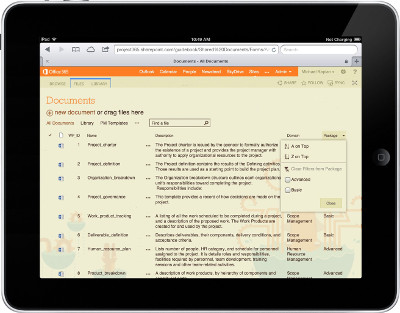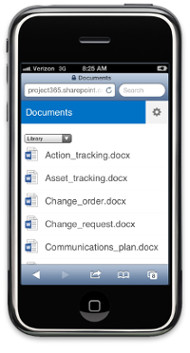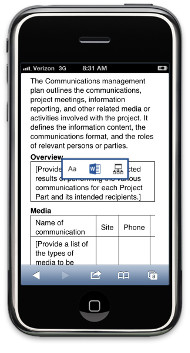2. The SoftPMO Toolkit and the New Project Manager
What does the new project manager need?
The new project manager needs to understand what a project is.
What are the different parts of a project?
How does a project differ from common, day-in-day-out, repetitive business processes?
What’s needed to start up a project?
Dennis D. McDonald, Ph.D.
The Toolkit’s Guidebook helps answer all these questions. Written in plain English, the Guidebook explains what goes into a project and how its constituent parts work together.
The new project manager needs to understand what a project manager does.
What are the first steps the project manager needs to take?
What needs to be communicated about the project to management and to project team members?
What role does the project manager play as the project moves from startup to execution?
Dennis D. McDonald, Ph.D.
The Toolkit’s Guidebook explains this so the new project manager can quickly relate concepts to action no matter what kind of project is being managed.
The new project manager needs to understand what resources are needed to run a project.
Understanding the resource side of project management is where the Toolkit’s 40+ customizable Process Templates come in, starting with the all-important Project charter.

All Templates are based on the SoftPMO Process Management Model.
They walk the new project manager through the project management process, step by step, using a straightforward, fill-in-the blank approach
Templates are divided into two groups, Basic and Advanced.
- Basic templates define the core set of processes all project managers need to understand.
- Advanced templates focus on more complex project governance, work breakdown structure, scheduling, performance reporting, and program management issues.
Each template, available in downloadable Microsoft Office format, is customizable and shareable. The roles and responsibilities of the different resources that touch on a project as it goes from startup through execution are clearly defined for the manager via a fill-in the blank approach. When the manager’s input is supplied, the Toolkit delivers a complete and organized view of the project in a form that can be easily shared with team members and management.
How does the New Project Manager Use the SoftPMO Project Management Toolkit?
The new project manager needs to:
- Learn the basics of the project management process using the Toolkit’s Guidebook.
- Apply the basics to a real project using the toolkit’s customizable Templates.
- Using the templates, collaborate and communicate with team members and stakeholders.

1. Learn the Basics
While there’s no substitute for on the job training when it comes to the practical world of project management, the reality is that the new project manager also needs a foundation for understanding the best way to plan, organize, and run a project.
Projects differ from standardized or recurrent processes or functions. They have a beginning, middle, and end. They frequently produce something measurable or tangible. They consume labor and nonlabor resources. They usually have intermediate phases or steps that need to be done in some sort of sequence.
These distinctions are not theoretical. They're real. Failing to understand them can lead to very real failures, including unsatisfied goals, cost overruns, late delivery, and negative career impacts.
This is where the SoftPMO Process Management Model and SoftPMO Process Management Guidebook come in.
Whether downloaded or used online, the Guidebook provides a clearly described and generalizable Project Management Process Model that describes the 6 key steps in all projects:
- Define the project involves defining the objectives, proposing a solution, then selecting the approach that provides the best solution.
- Plan the project involves formulating a baseline plan, integrating it with the project organization, and documenting the project sponsor’s authorization.
- Start the project involves engaging the resources and systems that will be used to manage the project.
- Monitor the project involves identifying, addressing, and resolving variations from the plan.
- Control the project involves keeping the project on track with the schedule and budget.
- Close the project involves performing closing activities and completing project.
The Guidebook breaks down and describes each step in jargon-free language in terms of goals, activities, sample scenarios, inputs, outputs, associated PMBOK knowledge areas, and project roles.
In summary, the Guidebook provides a generalizable model of the project management processes describes the steps involved in planning and managing the project, drills down into each step to present the unique aspects of each, and shows how each activity is supported by a set of ready to customize project documentation templates.
2. Apply the Basics
The Guidebook and the Model show how different components of a project work together. Next the new project manager applies this learning to a real project. This is where the SoftPMO Project Management Templates come in.
Templates are divided into a core set of “basic” templates relevant for all projects, plus “advanced” templates, which are for especially complex projects or situations where the project manager must oversee multiple projects.

The Guidebook links each step and activity in the SoftPMO Project Management Model to one or more individual process templates. For example, the first step in the SoftPMO Process, Define the Project, includes Define Objectives, Define Solution, Define Approach, and Define Scope. There are five customizable fill-in-the-blank templates associated with Define the Project:
- Project Charter Template
- Project Definition Template
- Organization Structure Template
- Work Product List Template
- Project Governance Template
Each template follows a “fill in the blank” model. Templates like this can be filled out as briefly or in as much detail as the project manager feels is necessary. Whatever the level of detail provided, the project manager then has a set of explicit statements about key project elements that can be discussed, reviewed, negotiated, and ultimately agreed to by the project’s team members, owners, and stakeholders. This simplifies communication, reduces the likelihood for disagreement, and facilitates progress reporting.
It also provides the new project manager with assurance that “ ... this is the most important stuff you need to pay attention to!”
3. Communicate and Collaborate
Assume the new project manager puts time and effort into studying the Guidebook and documenting the project using the “core” templates. Will this guarantee success?
Of course not. The project must be effectively staffed and managed with appropriate resources. But even when it is, the project can fail without an appropriate level of communication and collaboration.
The SoftPMO Project Management Toolkit is designed from top to bottom to facilitate effective communication and collaboration:
- The SoftPMO Model and All SoftPMO content are written and described in plain, jargon-free English compatible with concepts and terminology used in PMI’s PMBOK.
- Templates can be copied and customized whether individual copies are downloaded onto a local computer or managed online.
- As many copies as necessary can be made of the Templates as long as the Guidebook and Templates are not resold.
- Documents are organized, named, and numbered to make sorting and organization simple and straightforward.
- There are no restrictions on the use and sharing of documents via network and cloud based collaboration tools such as Microsoft SharePoint.
- The fundamental benefit of SoftPMO’s project management documentation for the new project manager is that it provides a mechanism for making key project decisions and responsibilities visible to all. This reduces uncertainty and miscommunication and helps keep everyone involved “on the same page.”
Bottom line: with the Toolkit SoftPMO has done the “heavy lifting” of defining and organizing for the new project manager the most important elements required for project success. SoftPMO goes beyond Gantt charts to ensure that essential business and management requirements are addressed.
For the new project manager this provides assurance that the most important elements of project management – and project success — are captured, visible, and available for attention by management and the project team.




